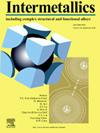Strain-rate sensitivity deformation behavior of high entropy alloy fibers
IF 4.8
2区 材料科学
Q2 CHEMISTRY, PHYSICAL
引用次数: 0
Abstract
Understanding strain rate sensitivity in high-entropy alloys (HEAs) is critical for applications in engines, motors, and microelectronics. Current research focuses on bulk HEAs at millimeter scales, leaving μm-scale behavior poorly understood. This study investigates Fe34Co29Ni29Al3Ta3Si2 HEA fibers with single-phase coarse-grained structures under varying tensile strain rates. Results demonstrate a 25 % increase in tensile strength and 18 % enhancement in elongation as the strain rate rises from 1 × 10−3 to 5 × 10−1 s−1. Deformation mechanisms transition from stacking faults, nano-grains, and L-C locks at lower rates to dislocation-dominated plasticity at higher rates driven by low stacking fault energy (∼26.15 mJ/m2). By integrating microstructural characterization with the Nemat-Nasser Li (NNL) model, we quantify the strain rate sensitivity parameter (from 0.005 to 0.03), activation volume and validate the dominance of dislocation slip at high strain rates. These findings bridge the knowledge gap in microscale HEA deformation, offering a predictive framework for engineering applications.
高熵合金纤维的应变率敏感变形行为
了解高熵合金(HEAs)的应变率敏感性对于发动机,电机和微电子的应用至关重要。目前的研究主要集中在毫米尺度的大块HEAs,对μm尺度的行为知之甚少。本文研究了不同拉伸应变速率下具有单相粗晶结构的Fe34Co29Ni29Al3Ta3Si2 HEA纤维。结果表明,当应变速率从1 × 10−3增加到5 × 10−1 s−1时,拉伸强度提高25%,伸长率提高18%。变形机制从较低速率的层错、纳米颗粒和L-C锁转变为由较低的层错能(~ 26.15 mJ/m2)驱动的较高速率的位错主导的塑性。通过将微观结构表征与Nemat-Nasser Li (NNL)模型相结合,我们量化了应变率敏感性参数(从0.005到0.03)和激活体积,并验证了位错滑移在高应变率下的主导作用。这些发现弥补了微尺度HEA变形的知识差距,为工程应用提供了预测框架。
本文章由计算机程序翻译,如有差异,请以英文原文为准。
求助全文
约1分钟内获得全文
求助全文
来源期刊

Intermetallics
工程技术-材料科学:综合
CiteScore
7.80
自引率
9.10%
发文量
291
审稿时长
37 days
期刊介绍:
This journal is a platform for publishing innovative research and overviews for advancing our understanding of the structure, property, and functionality of complex metallic alloys, including intermetallics, metallic glasses, and high entropy alloys.
The journal reports the science and engineering of metallic materials in the following aspects:
Theories and experiments which address the relationship between property and structure in all length scales.
Physical modeling and numerical simulations which provide a comprehensive understanding of experimental observations.
Stimulated methodologies to characterize the structure and chemistry of materials that correlate the properties.
Technological applications resulting from the understanding of property-structure relationship in materials.
Novel and cutting-edge results warranting rapid communication.
The journal also publishes special issues on selected topics and overviews by invitation only.
 求助内容:
求助内容: 应助结果提醒方式:
应助结果提醒方式:


